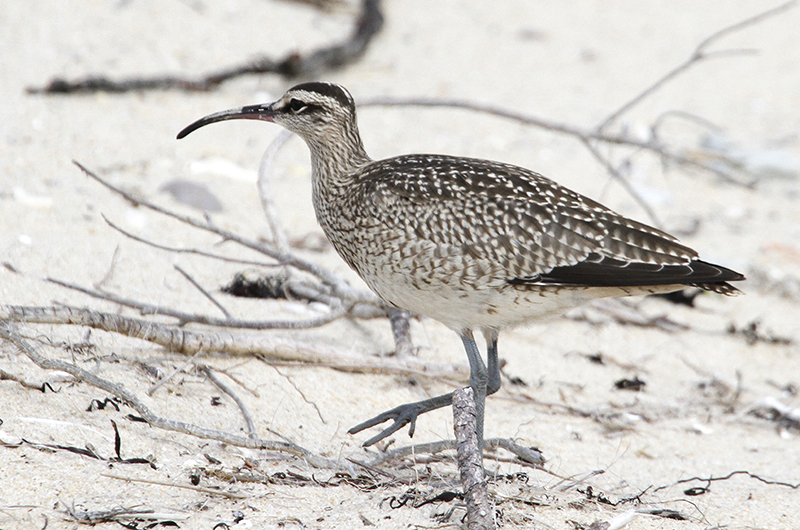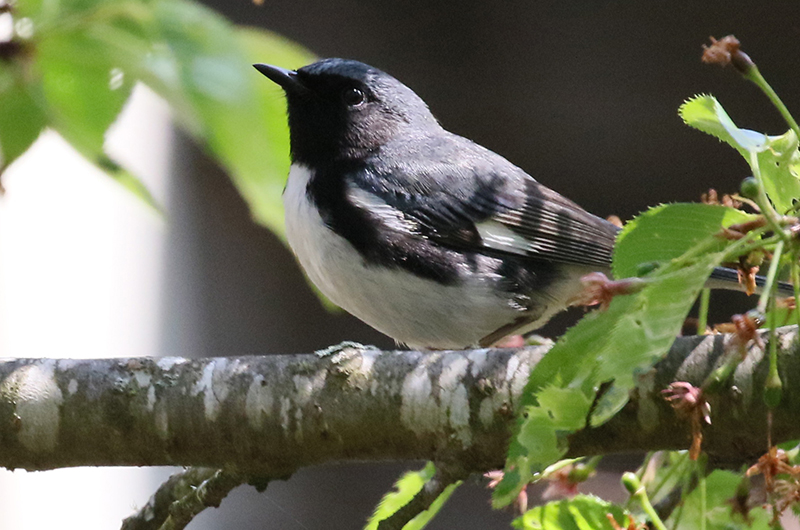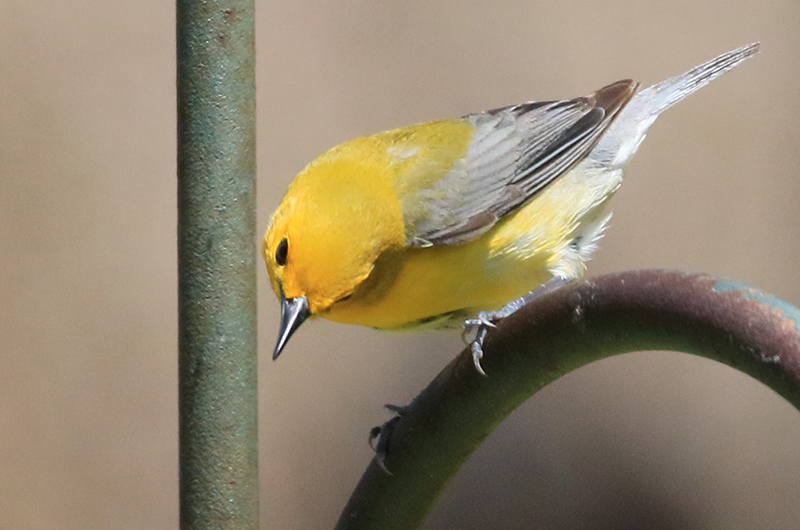The middle of May has come and gone and migration is at or near its peak. Most of the warblers that nest here have returned: northern parula, yellow, pine, prairie, black-and-white, redstart, ovenbird and yellowthroat. But where are the more than 20 warblers that do not nest here? Several decades back we would see more than half of these transients on their northward migration, and we would see multiple individuals of each in one morning. A lot of us were out looking for them on May 15 to 17, when weather conditions were favorable for these nocturnal migrants.
Black-throated blue warblers were the most widely sighted transient warbler. On May 16 they were observed by Hans Goeckel in his yard, while Lanny McDowell had two males in his yard. Five of us saw one individual at the Oak Bluffs pumping station (wearing masks were Bob Shriber, Margaret Curtin, Luanne Johnson, Nancy Weaver, and myself), and on May 17 I saw one at Brightwood Park. That is only five birds. Two yellow-throated warblers were spotted. I saw one at the pumping station and Luanne Johnson heard and saw one in her Oak Bluffs yard. A magnolia warbler was also spotted at the Pumping Station, while Bob Shriber saw a prothonotary warbler at Priester’s Pond, and a Nashville warbler was spotted by Susan Whiting and Allan Keith at the Edgartown Golf Club.
Why aren’t these migrating warblers more plentiful? Unfavorable winds out of the north and east have predominated in April and May, but that should not have affected us because we had favorable conditions those days. And Doppler radar stations report strong numbers of migrating birds in the Cape and Islands area (technology is amazing). Unfortunately, another possible contributing factor for the observed scarcity is that overall bird populations have declined by about one third in the past 50 years. Sounds to me like someone needs to write a sequel to Rachel Carson’s Silent Spring.
Of our nesting species, Lanny McDowell has spotted northern parulas at Old Farm Road and a prairie warbler at the Chilmark Pond Preserve on May 16. Also that day I saw both common yellowthroats and yellow warblers at the pumping station, while the state forest had ovenbirds and prairie warblers and Brightwood Park hosted black-and-white, yellowthroat, parula and pine warblers. At Watcha Pond, Phil Edmundson spotted yellowthroats, ovenbirds, yellow warblers, while others of the latter species were seen at the Edgartown Golf Club by Ken Magnuson, Susan Whiting and Allan Keith. Nelson Smith reports redstarts along the Mill Brook at Waskosim’s Rock Reservation on May 12. Our resident warblers do not appear to be unusually scarce, but reaching their nesting territories is a spring priority for them, so they will fight their way into the adverse winds.
Bird Sightings
Of course the migration season is not just about warblers and there are other birds to report. Susan Whiting and Allan Keith spotted the first red-eyed vireo of the season at Priester’s Pond on May 17. Their arrival is right on schedule.
To see one whimbrel is an amazing sight but Matt Pelikan saw a flock of seven of these large shy shorebirds on Chappaquiddick on May 13, another first for the season. He also saw a short-billed dowitcher and a lesser yellowlegs. On May 16 I observed a large flock of 65 short-billed dowitchers on the tidal flats of Norton Point Beach.
Luanne Johnson and Ken Magnuson both observed the first spotted sandpipers on May 16. The former sighting was at the Oak Bluffs pumping station while the latter was at the Edgartown Golf Club. Another new arrival at the golf club was a bobolink. Francesca Zeta also spotted a bobolink at the Farm Institute.
Emma Green-Beach reports the sandhill crane is still visiting her Oak Bluffs yard on May 16. This bird also ventured a short distance to the Preserve, a development off County Road, where it was observed by Maureen and Greg Clark on May 13.
Some ducks are lingering. Jeff Bernier observed both red-breasted mergansers and bufflehead at Little Beach on May 13. A lingering red-throated loon was seen up close on Mattakessett Bay on May 16 by both Hans Goeckel and myself. Most of these three species are all well north of us by now.
Another lingering species is a purple sandpiper that I saw in near-breeding plumage as it foraged on the old derelict jetties between the end of the seawall and Harthaven on May 16. I did not see fish crows in Ocean Park but there were three of them near the Big Bridge on State Beach. The horned larks nesting on State Beach were easy to find.
Of course, resident species are also in the news. A raven visited Jeff Bernier’s Edgartown yard on May 16, then on May 18 I spotted one perched on top of the telephone tower at the Verizon building.
Eleanor Stanwood found a bobwhite in the Lucy Vincent parking lot on May 12.
Two brown thrasher sightings come from Kath MayWaite in Chilmark on May 16, and Larry Helper had one visit his feeders on May 9.
Some of the really colorful birds are still hanging around. Baltimore orioles are seemingly everywhere and they breed here. Evidence of nesting comes from observations of nest building as observed by Laurie Meyst at Sheriff’s Meadow Sanctuary and Lanny McDowell at the pumping station. An orchard oriole and a rose-breasted grosbeak were spotted by Stan and Marie Mercer. The latter species has also been spotted by Greg Pattison, Sarah Carr, Daniel Mayhew, Tim Rush, Allan Carney, Alan Slater and Paul Bailey.
Tanagers are still visiting feeders. Scarlet tanagers are reported by Samantha Hartley, Allison Schmidt and by Bridgett Dunnegan and Sea Williams. The less common summer tanagers have been reported by Marie Larsen and Don and Linda Sibley.
Robert Culbert is an ecological consultant with Nature Watch LLC living in Vineyard Haven.










Comments
Comment policy »